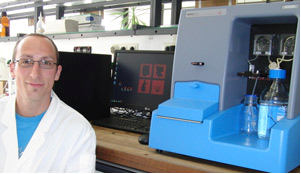Aug 1 2013
NanoSight announces the release of a new NS500 instrument with a Dynamic Light Scattering (DLS) module, which will take the lower size limit of detection down to around 4 nm in diameter.
NanoSight is pleased to announce the launch of the first DLS-enabled version of their widely-used NS500 instrument. For the first time these two powerful and complementary techniques come together in one instrument, designated NanoSight NS500+DLS. This gives all the benefit of NTA in high resolution sizing, with DLS extending the lower detection limit to 4 nm.
Bob Carr, NanoSight's founder and CTO, described the rationale of having these techniques alongside one another; "These two technologies address sub-micron particle characterization very differently. While both NTA and DLS exploit Brownian motion and use laser illumination to deliver hydrodynamic particle diameter, there the commonality ends.
DLS measures time-based fluctuations of coherent light caused by Brownian motion, whereas with NTA the scatter of laser-illuminated particles in Brownian motion is visualized and particles are individually tracked. DLS is fast, accurate and precise on monodispersed samples. However its essential limitation, being an ensemble technique, is that the size distribution it reports is frequently unrepresentative for complex, polydisperse samples.
In contrast, NTA's particle size distribution is of much higher resolution, but with a higher lower limit of detection of between 10 and 35 nm, dependent principally on the sample type. We see NTA as the instrument of choice, for the range it covers (nominally 10 - 2,000 nm), but some work demands a lower limit of detection.
 Daniel Moldenhauer uses the new NS500+DLS in the Groehn group at the University of Erlangen-Nürmberg.
Daniel Moldenhauer uses the new NS500+DLS in the Groehn group at the University of Erlangen-Nürmberg.
Here DLS can contribute an extension down to around 4 nm. This extra range is particularly useful for the study of the earliest stages of protein aggregation, where dimerization and subsequent growth of aggregates from monomeric state can be observed. We also see a significant contribution in the study of the potential toxicology of engineered nanomaterials where dispersion quality assessment of particles less than approximately 20 nm cannot currently be met by NTA".
In the NS500+DLS, the DLS software is integrated into the NTA suite, providing easy interchange between NTA and DLS data collection. The DLS data reported is Z-average diameter, Polydispersity Index (PDI) and Particle Size Distribution (PSD).
Daniel Moldenhauer of the Chemistry & Pharmacy Department from the University of Erlangen-Nürmberg in Germany was part of the evaluation team that trialled the Beta version of the NS500+DLS. He said "It is easy to use and the operator can't really make any mistakes. We have another commercial DLS system and the data from it and the NanoSight NS500+DLS are comparable."
Carr continues "A second benefit to the wider detection range that this combination brings is that NTA informs the reliability of the DLS data. DLS is notoriously vulnerable to larger contaminant particles, which produce a spurious but difficult to diagnose shift of the particle size distribution to the right. With NTA, such contaminants are immediately evident. So we have NTA addressing this DLS weakness, resulting in an NTA-endorsed DLS result".
CEO Jeremy Warren adds "Previously we have provided NTA to existing DLS users, who recognise the strengths and limitations of the latter. With the NanoSight NS500+DLS we combine both on one platform. The concentration and fluorescence measurands from NTA make this an appealing package for multiparameter, sub-micron particle characterization."
About NanoSight
NanoSight delivers the world's most versatile and proven multi-parameter nanoparticle analysis in a single instrument.
NanoSight's "Nanoparticle Tracking Analysis" (NTA) detects and visualizes populations of nanoparticles in liquids down to 10 nm, dependent on material, and measures the size of each particle from direct observations of diffusion. Additionally, NanoSight measures concentration while a fluorescence mode differentiates suitably-labelled particles within complex background suspensions.
Zeta potential measurements are similarly particle-specific. It is this particle-by-particle methodology that takes NTA beyond traditional light scattering and other ensemble techniques in providing high-resolution particle size distributions and validates data with information-rich video files of the particles moving under Brownian motion.
This simultaneous multiparameter characterization matches the demands of complex biological systems, hence its wide application in development of drug delivery systems, of viral vaccines, and in nanotoxicology. This real-time data gives insight into the kinetics of protein aggregation and other time-dependent phenomena in a qualitative and quantitative manner. NanoSight has a growing role in biodiagnostics, being proven in detection and speciation of nanovesicles (exosomes) and microvesicles.
NanoSight has installed more than 600 systems worldwide with users including BASF, GlaxoSmithKline, Merck, Novartis, Pfizer, Proctor and Gamble, Roche and Unilever together with the most eminent universities and research institutes. NanoSight's technology is validated by 850+ third party papers citing NanoSight results. NanoSight's leadership position in nanoparticle characterization is consolidated further with publication of an ASTM International standard, ASTM E2834, which describes the NTA methodology for detection and analysis of nanoparticles.